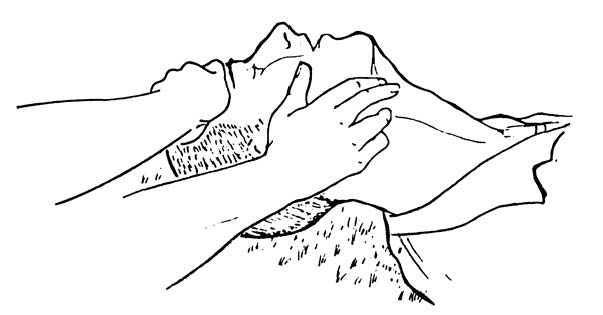Cardiopulmonary Resuscitation
LESSON 3: INITIATE RESCUE BREATHING ON AN ADULT
3-11
3-11. CHECK CAROTID PULSE
Check the casualty's pulse after you have successfully administered the two initial ventilations. Getting fresh air into the casualty's lungs will not help if his heart is not beating and the blood is not circulating. There are two major arteries, called the carotid arteries, in the neck. One artery lies in a grove on the left side of the trachea (windpipe); the other lies in a groove on the right side of the trachea. Either artery may be used to check the casualty's carotid pulse, but you will normally use the artery on the side of the neck closest to you. The carotid pulse is used because you are already near the neck, it is easily accessible, and a pulse can sometimes be felt at the carotid artery when the pulse may be too weak to be detected at arteries farther from the heart. It is also typical to check the radial pulse at the same time as the carotid pulse.
a. Locate Pulse Site. Place the index and middle fingers of your hand on the casualty's trachea or larynx. Then slide your fingers toward you while gently pressing on the neck until you find the groove running parallel to the airway (figure 3-9).
(1) If you are using the chin-lift/head-tilt, remove your hand from the casualty's chin and use that hand to locate the pulse site. Keep your other hand on his forehead and maintain the head-tilt.
(2) If you are using the jaw-thrust, use your dominant hand to check for a pulse while maintaining the casualty's airway with the other hand.
(3) Three fingers (index, middle, and ring fingers) can be used instead of only two fingers.
CAUTION: Do not use your thumb. The thumb has a detectable pulse and you may
mistake the pulse in your thumb for the casualty's pulse.
b. Feel for Pulse. Press gently on the carotid artery with your fingertips. Allow enough time to detect a pulse that is weak, slow, and/or irregular. The check should take between 5 and 10 seconds.
Figure 3-9. Locating the carotid pulse.
c. Evaluate the Pulse Check.
(1) If no pulse can be felt, cardiopulmonary resuscitation is required immediately. The procedures for administering cardiopulmonary resuscitation are given in Lesson 4.
(2) If a pulse can be felt, determine the rate and quality of the pulse. Ensure that the pulse is adequate to sustain life. (A pulse of less than 40 beats per minute [BPM] is not adequate to sustain life in most adults and CPR should be started.) Administer the rescue breathing procedures given in paragraph 3-12.


